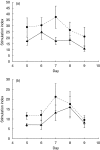Autoimmune T cell responses to seminal plasma in chronic pelvic pain syndrome (CPPS)
- PMID: 12041509
- PMCID: PMC1906385
- DOI: 10.1046/j.1365-2249.2002.01853.x
Autoimmune T cell responses to seminal plasma in chronic pelvic pain syndrome (CPPS)
Abstract
The aetiology of chronic prostatitis is not understood. The aim of this study is to investigate an autoimmune hypothesis by looking for T cell proliferation in response to proteins of the seminal plasma. We studied peripheral blood mononuclear cell proliferation from 20 patients with chronic prostatitis and 20 aged-matched controls in response to serial dilutions of seminal plasma (SP) from themselves (autologous SP) and from a healthy individual without the disease (allo-SP). We found that the patients have a statistically greater lymphocyte proliferation to autologous SP at the 1/50 dilution on day 6 compared to controls (P = 0 x 01). They also have a greater proliferation to allo-SP on both day 5 (P = 0 x 001) and day 6 (P = 0 x 01) at the same dilution. Using a stimulation index (SI) of 9 to either autologous SP or allo-SP on day 6 at the 1/50 dilution as a definition of a proliferative response to SP, then 13/20 patients as compared to 3/20 controls showed a proliferative response to SP (P = 0 x 003, Fishers exact test). These data support an autoimmune hypothesis for chronic prostatitis.
Figures



References
-
- National Institutes of Health (NIH) National Institute of Diabetes and Digestive and Kidney Diseases Workshop on Chronic Prostatitis: Summary Statement. Bethseda, MD: United States Department of Health and Human Services; 1995. December.
-
- Collins MM, O’Leary MP, Barry MJ. Prevalence of bothersome genitourinary symptoms and diagnoses in younger men on routine primary care visits. Urology. 1998;52:422–7. - PubMed
-
- Collins MM, Stafford RS, O’Leary MP, Barry MJ. How common is prostatitis? A national survey of physician visits. J Urol. 1998;159:1224–8. - PubMed
-
- Wenniger K, Heiman JR, Rothman I, Berghuis JP, Berger RE. Sickness impact of chronic nonbacterial prostatitis and its correlates. J Urol. 1996;155:965–8. - PubMed
Publication types
MeSH terms
LinkOut - more resources
Full Text Sources
Other Literature Sources
Medical

